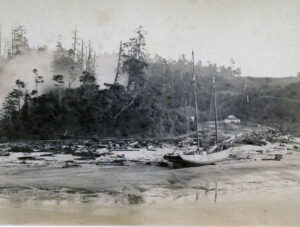
Sometimes a researcher can find a link to Mendocino coastal history when you least expect it. Sorting archive materials at the Kelley House Museum I discovered artist David Thimgan.
In a 1994-95 winter issue of Sea History magazine, I came across a story called “Rediscovering the Pacific Trade: Maritime Paintings of David Thimgan.” Being a retired librarian, I was peeved to discover an inaccuracy in the first eight words of the story, but I am willing to be forgiving of authors who are not local. The journalist writes about the painter sitting on a bluff over the Mendocino River. That’s Big River. . .
What drew me into the story was a painting of the schooner “Alice Kimball,” which I knew was built in Little River in Thomas Petersen’s shipyard. So, here’s information on a painter who REALLY knew his subject matter.
Some artists sketch. Thimgan carried a sketchbook, tape recorder, topographic maps, binoculars and a camera when he studied a location. He recorded his impressions of shimmering low-angle light and diffusing mists. He made a mental overlay of a scene from a hundred years ago against a modern backdrop. In his Mendocino-based images he knew where the old lumber chute was and where the coastal schooners would have anchored.
Thimgan created historically accurate and visually appealing portrayals of long forgotten ships and vanished harbors. He understood that in marine art little attention had been given to the nineteenth century Pacific Coast. He also believed that there was little published material or visual documentation of the Mendocino Coast in particular, and probably never found the Kelley House and Guest House Museums, because we do have such resources.
So Thimgan painted maritime history after doing exhaustive research. He particularly liked ship builder Thomas Petersen, who had a shipyard at Little River but built vessels at many locations in the Pacific Northwest. Petersen’s ships had a reputation among seafarers for their speed and beauty. Of the 23 vessels built locally, Thimgan painted flyers “Sea Foam,” and “Galatea” and schooner “Alice Kimball.” He also painted the “Maxim,” owned by the Caspar Lumber Company.
The painter had no formal art training. He did no sketching on his canvas but painted background and then used a detail brush to draw in vessel outlines. Using finer and finer brushes he made his images emerge from the canvas. His use of light upon vessels and reflected in water is impressive. I’m not an art connoisseur but I really enjoyed the images of his work in the magazine article. Others seemed to like it, too, as Thimgan’s painting were selling for over $10,000 each when he died in 2003.
To learn more about Thomas Petersen’s extraordinary shipbuilding here on our coast, visit our Online Collections and use keywords such as “ships” “shipbuilding” or “Petersen” to view photographs and documents from our more than 7,000 archived images. https://mendocinohistory.pastperfectonline.com/